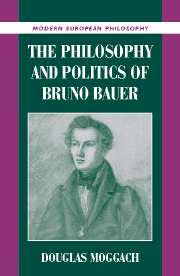Book contents
- Frontmatter
- Contents
- Preface
- THE PHILOSOPHY AND POLITICS OF BRUNO BAUER
- Introduction: “The Friend of Freedom”
- I FOUNDATIONS: AESTHETICS, ETHICS, AND REPUBLICANISM
- II JUDGING THE OLD ORDER
- III THE EMANCIPATORY PROJECT
- IV JUDGING THE REVOLUTIONARY MOVEMENT
- Epilogue: After the Revolution: The Conclusion of the Christian-Germanic Age
- Appendix: Bruno Bauer, “On the Principles of the Beautiful” (1829)
- Notes
- Bibliography
- Index
Appendix: Bruno Bauer, “On the Principles of the Beautiful” (1829)
Published online by Cambridge University Press: 05 June 2012
- Frontmatter
- Contents
- Preface
- THE PHILOSOPHY AND POLITICS OF BRUNO BAUER
- Introduction: “The Friend of Freedom”
- I FOUNDATIONS: AESTHETICS, ETHICS, AND REPUBLICANISM
- II JUDGING THE OLD ORDER
- III THE EMANCIPATORY PROJECT
- IV JUDGING THE REVOLUTIONARY MOVEMENT
- Epilogue: After the Revolution: The Conclusion of the Christian-Germanic Age
- Appendix: Bruno Bauer, “On the Principles of the Beautiful” (1829)
- Notes
- Bibliography
- Index
Summary
Dissertation on the principles of the beautiful, which Kant exposed in that part of his philosophy which he intended as a critique of the faculty of judgement.
Motto: “Seriousness in Art is its Serenity.”
(66 [b]) After two millennia of the labour of spirit [ingenii], the philosophy of Kant arose, and through a great revolution opened the way to the new philosophy. In order to ascertain the power and movement of this philosophical system, we must briefly indicate the antecedent principles of philosophical science, for the system can only be understood through its antecedents.
Every philosophy wanted to examine the principle of thinking and being, and to discover their
(67 [a]) common source. For this indeed is the eternal idea, that in God being and thinking are not separate. Thus philosophical thinking is divine thinking, since it endeavours to examine that unity, that source, as it is in God. But since Greek philosophy derived from the immediate unity of being and thinking, the opposition [between these terms] could neither be overcome nor abolished. Now Parmenides very simply enunciated this immediate unity: to einai esti and to einai esti to noein. His teaching will remain forever true, [but] not because he penetrated as far as division and opposition, nor because he correctly mediated the truth by means of these [distinctions]. The philosophy of Plato,
(67 [b]) as well, is founded upon the concord of things and idea: for according to his teaching only the notion or the idea is, and the idea is the truth of things.
- Type
- Chapter
- Information
- The Philosophy and Politics of Bruno Bauer , pp. 188 - 212Publisher: Cambridge University PressPrint publication year: 2003



